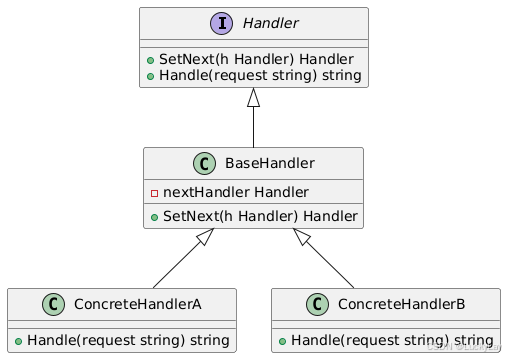Golang学习笔记_40------模版方法模式
Golang学习笔记_41------观察者模式
Golang学习笔记_42------迭代器模式
文章目录
一、核心概念
1. 定义
责任链模式 是一种行为型设计模式 ,允许将请求沿着处理链传递,直到有对象处理它。其核心特点包括:
• 解耦请求与处理 :发送者无需知道具体处理者
• 动态链式处理 :可动态调整处理链顺序和组成
• 职责单一性:每个处理者专注特定类型请求
2. 解决的问题
• 复杂条件分支 :避免大量if-else判断语句
• 请求处理流程扩展 :新增处理节点不影响现有逻辑
• 分布式责任:多层级审批/验证场景
3. 核心角色
| 角色 | 作用 |
|---|---|
| Handler | 定义处理请求的接口,包含设置下家的方法 |
| ConcreteHandler | 具体处理逻辑实现,决定处理或传递请求 |
| Client | 组装责任链并触发首个处理者 |
4. 类图

plantuml
@startuml
interface Handler {
+ SetNext(h Handler) Handler
+ Handle(request string) string
}
class BaseHandler {
- nextHandler Handler
+ SetNext(h Handler) Handler
}
class ConcreteHandlerA {
+ Handle(request string) string
}
class ConcreteHandlerB {
+ Handle(request string) string
}
Handler <|-- BaseHandler
BaseHandler <|-- ConcreteHandlerA
BaseHandler <|-- ConcreteHandlerB
@enduml二、特点分析
优点
- 解耦性强:请求发起方与处理方解耦
- 开闭原则:新增处理节点不影响现有代码
- 灵活组合:可动态调整处理链结构
缺点
- 性能损耗:长链路导致请求处理延迟
- 调试困难:请求可能未被处理且无反馈
- 循环风险:错误配置导致无限循环
三、适用场景
1. 多级审批流程
go
// 采购审批实现示例
type PurchaseRequest struct {
Amount float64
Purpose string
}
type Approver interface {
SetNext(Approver)
ProcessRequest(PurchaseRequest) bool
}
type Manager struct {
next Approver
}
func (m *Manager) SetNext(next Approver) {
m.next = next
}
func (m *Manager) ProcessRequest(req PurchaseRequest) bool {
if req.Amount <= 5000 {
fmt.Println("经理审批通过")
return true
}
if m.next != nil {
return m.next.ProcessRequest(req)
}
return false
}2. 用户身份验证
go
// 多因素认证链
type AuthHandler interface {
SetNext(AuthHandler)
Handle(*User) bool
}
type PasswordHandler struct {
next AuthHandler
}
func (p *PasswordHandler) SetNext(h AuthHandler) {
p.next = h
}
func (p *PasswordHandler) Handle(u *User) bool {
if !verifyPassword(u) {
return false
}
if p.next != nil {
return p.next.Handle(u)
}
return true
}3. 日志处理系统
go
// 多级日志处理器
type LogLevel int
const (
DEBUG LogLevel = iota
INFO
ERROR
)
type Logger interface {
SetNext(Logger)
Log(string, LogLevel)
}
type EmailLogger struct {
level LogLevel
next Logger
}
func (e *EmailLogger) Log(msg string, l LogLevel) {
if l >= e.level {
fmt.Printf("发送邮件日志: %s\n", msg)
}
if e.next != nil {
e.next.Log(msg, l)
}
}四、Go语言实现示例
完整实现代码
go
package chainofresponsibility
import "fmt"
type Handler interface {
SetNext(Handler) Handler
Handle(string) string
}
type BaseHandler struct {
next Handler
}
func (b *BaseHandler) SetNext(h Handler) Handler {
b.next = h
return h
}
func (b *BaseHandler) Handle(s string) string {
if b.next != nil {
return b.next.Handle(s)
}
return ""
}
type AuthHandler struct {
BaseHandler
}
func (a *AuthHandler) Handle(req string) string {
if req == "auth" {
fmt.Println("执行身份验证")
return "AUTH_SUCCESS"
}
return a.BaseHandler.Handle(req)
}
type LoggingHandler struct {
BaseHandler
}
func (l *LoggingHandler) Handle(req string) string {
fmt.Printf("记录请求日志: %s\n", req)
return l.BaseHandler.Handle(req)
}
// 客户端使用示例
func ExampleChain() {
handlers := &AuthHandler{}
handlers.SetNext(&LoggingHandler{})
fmt.Println(handlers.Handle("auth"))
fmt.Println(handlers.Handle("data"))
}执行结果
text
=== RUN TestExampleChain
执行身份验证
AUTH_SUCCESS
记录请求日志: data
--- PASS: TestExampleChain (0.00s)
PASS五、高级应用
1. 动态链路配置
go
type ChainBuilder struct {
head Handler
tail Handler
}
func (c *ChainBuilder) AddHandler(h Handler) {
if c.head == nil {
c.head = h
c.tail = h
return
}
c.tail.SetNext(h)
c.tail = h
}
func (c *ChainBuilder) Execute(req string) {
if c.head != nil {
c.head.Handle(req)
}
}2. 熔断机制
go
type CircuitBreakerHandler struct {
BaseHandler
failureCount int
threshold int
}
func (c *CircuitBreakerHandler) Handle(req string) string {
if c.failureCount >= c.threshold {
fmt.Println("熔断器已触发")
return ""
}
result := c.BaseHandler.Handle(req)
if result == "ERROR" {
c.failureCount++
}
return result
}六、与其他模式对比
| 模式 | 核心区别 | 典型场景 |
|---|---|---|
| 命令模式 | 请求封装 vs 请求传递 | 撤销操作管理 |
| 策略模式 | 算法选择 vs 处理流程控制 | 支付方式选择 |
| 装饰器模式 | 功能叠加 vs 责任传递 | 动态添加功能 |
七、实现建议
- 链路终止控制:增加处理成功标志位
- 优先级控制:实现带权重的处理节点
- 异步处理:结合goroutine实现并行处理链
- 监控埋点:记录各节点处理耗时和状态
八、典型应用
- 中间件管道:Gin框架的中间件链
- 风控系统:多规则顺序校验
- 订单处理:库存检查→支付→物流的链式处理
- API网关:认证→限流→日志记录的处理流程
通过责任链模式,可以有效处理需要多层级决策的业务场景。在Go语言中,利用接口和结构体组合的特性,可以构建灵活可扩展的处理链路。建议在以下场景优先考虑:
- 存在多个可能处理请求的对象
- 需要动态指定处理流程
- 处理流程需要灵活变更
- 需要解耦请求发送者和接收者